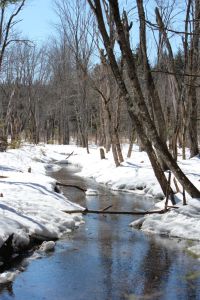My friend and former flatmate, Marfé, sent me the following Lenten reflection shared by Reverend John Branson of Christ Church in Alexandria, Virginia.
March 18, 2015
Ordinary Graces, Christian Teachings on the Interior Life by Lorraine Kisly includes this summary from a D.H. Lawrence essay:
When the wonder has gone out of the man he is dead. When all comes to all, the most precious element in life is wonder. Love is a great emotion and power is power but both love and power are based on wonder. Plant consciousness, insect consciousness, fish consciousness, animal consciousness, all are related by one permanent element, which many called the religious element in all life, even in a flea: the sense of wonder. That is our sixth sense. And it is the natural religious sense.
And so I begin today’s wander. Wondering about water and ice. It’s such an ordinary occurrence. Or is it?
A forester friend and I visited the Wilson Wing Moose Pond Bog Reserve this morning. Deer tracks led us to one of our first finds. The breakfast of champions appears to have been polypores. We always talk about deer eating mushrooms, but here was actual evidence.
I’d just been to this property on Friday, but today–different things made themselves known. There were deer, mink, snowshoe hare and maybe otter or raccoon tracks. The latter two were a bit difficult to determine given the snow conditions. Crusty snow. 15 degrees. Wind. Blustery wind.
Following the brook and mink tracks, we came to an area where either the otter or raccoon had also traveled. And then we saw the feathers in the water and on the ice. Not many. But enough to make us wonder what had happened. Did a hawk or owl get another bird? It certainly didn’t seem like a four-legged animal attack.
Along the edge of the bog we found this small nest flapping in the wind. Paper wasps, hornets and yellow jackets are all masters of papermaking. That being said, they locate their nests in different places. For the paper wasp, prime real estate is in trees and dense shrubbery, but quite often you’ll find their nests suspended from eaves and window casings. Trees and shrubs are a hornet’s site of choice. Yellow jackets set up housekeeping underground. My thinking is that this may have been the start of a hornet nest. Last spring, the queen who had overwintered in rock cracks, under bark or in an underground hangout, would have emerged and begun building by gathering wood fibers and turning them into papery pulp. But it appears that she abandoned it. Why? What went wrong on the home front?
Here’s something else to wonder about. The trail doesn’t go past this because it’s in a wet area beside the brook, but during the winter we can wander to places we can’t reach in other seasons. This hemlock was girdled by a beaver a while ago. I’m not sure why they do this as hemlocks are not their tree of choice for food. One theory is that the tree will die and other more favorable trees–from the beaver’s viewpoint–will grow here.
I’m always amazed how once my eyes are opened to something, it suddenly appears everywhere I look. Well, not everywhere but . . . Such was the case with the squiggly wound of another hemlock tree. So I asked my friend about this. His theory–a frost crack and this is how the tree tried to heal the wound. Maybe so. I know that I appreciate the sun’s warmth being absorbed by my black snow pants. The dark bark of the trees also absorbs sunlight during the day, but they don’t have a heated home to return to at night when the sun sets and temperature plunges. The constant thawing/freezing cycle creates cracks in the bark–but if this is such, I still don’t understand why the hemlock portrays the squiggly line, while frost cracks on other trees tend to be much straighter. Then again, all tree species have their own patterns and idiosyncrasies. Maybe I just have to accept that this is the way it is. And move on.
So we moved on to the John A. Segur Wildlife Refuge on New Road, another GLLT property. I’ve said it before and I’ll say it again . . . and again. I’m thankful to this land trust and others for the work being done to protect the ecosystem for the benefit of nature and humans.
And I’m thankful for another beautiful day in Maine and the opportunity to wonder about the ordinary.









My friend, Parker Veitch, a mycologist, shared the following with me about the birch polypore that the deer had eaten in my photo: “Native people used Piptoporus betulinus (birch polypore) to clean the digestive system of worms, parasites, etc. Recent research has also shown that it boosts the immune system, is a antibiotic, has anti-inflammatory properties, and many other medicinal uses. It can also be used as a ‘strop.'” To use as a strop, cut the polypore into a rectangular piece, dry it out until it’s hard and then use it to sharpen a razor or knife. Pretty cool stuff.
LikeLike
Very much enjoyed this multi-layered piece. Beautiful.
LikeLike
Thanks for stopping by and wondering along with me.
LikeLiked by 1 person